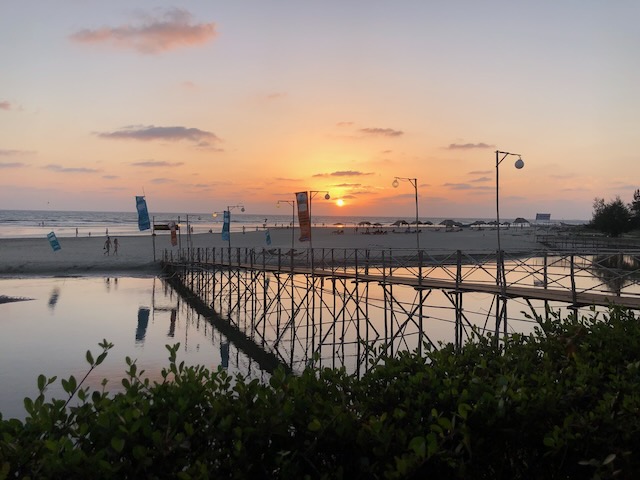
Goa
Toward the end 2022 while I was in Progreso, Mexico, I realized that I had become quite disconnected from my spiritual practices since the pandemic hit in early 2020. I had abruptly stopped teaching yoga, which for six years had been a grounding force that kept me rooted in my yoga and meditation practices.
I started grad school a few months later and completed my master’s program within a year and a half, attending classes through the summers without a break. A year after starting school I started an accounting business, which grew more rapidly than I could have ever imagined. I wrestled constantly with trying to find balance between my work and school responsibilities and my life outside of work. In the midst of finals during my last semester, I had to put my 16-year-old dog to sleep. Immediately after that, I headed to Mexico for four months and had an intense love affair with a married woman that ultimately ended in heartbreak. As soon as it ended, I jumped into another relationship which started strong, but experienced some turbulence during my two-month trip back to Mexico that fall. While I was back in Mexico, my Mexican ex-girlfriend re-entered my life and exited again just as quickly. It was a challenging couple of years to say the least.
I knew I needed to get back on track with my spiritual practices. India popped into my mind. India is the epitome of spirituality, and the idea of hunkering down in an ashram meditating and doing yoga for a couple of months sounded like just what I needed. When I commit to something, I am all in, and sometimes the most drastic approach is also the most direct and effective approach for me. It can also be easier to dive into something when you are away from your day-to-day responsibilities and commitments at home. I started to research where I wanted to go and initially thought about going back to Rishikesh. The only drawbacks were that I had already been there twice, and that it would also be winter during the time I was hoping to escape from the winter weather in Denver. It doesn’t get as cold in India as it does in Denver, but like Mexico, there is no central heat or even space heaters in the ashrams in India. I experienced this during my first visit and wasn’t excited about the idea of having to sleep in a sleeping bag in my bed again to stay warm at night. So, I started to research ashrams in Goa and Kerala, two states in southern India that are not only warm during the beginning of the year but are also located along the Arabian Sea.
I struggled to find an ashram in any of the locations I searched whose schedule would allow time for me to work. Many ashrams in India are quite strict and expect the guests to attend all daily offerings which generally begin with early morning yoga and meditation and end with yoga classes and kirtan ceremonies, with philosophy classes and karma yoga duties in between. There are small pockets of time carved into the schedules for breaks, but not enough time for me to keep up with my work. Many ashrams don’t even offer WiFi to encourage participants to unplug during their stay. All of this sounded wonderful, but unfortunately not practical for me as a business owner with 20+ clients.
I decided to do one final search and then potentially give up and pivot in another direction. That search yielded an ashram in Mandrem, Goa, called Preksha Yoga Ashram. I perused the schedule and saw plenty of space in between classes that would allow time for work. I contacted the ashram owner, and he was responsive and accommodating. He explained that the ashram schedule was flexible and that the guests were permitted to participate as much or as little as they wanted. They welcomed digital nomads and provided WiFi on the premises. They offered private rooms and cabins with private bathrooms, which is a rarity in most ashrams. They also had an ayurvedic doctor onsite with offerings of ayurvedic massages and detox treatments. And perhaps the best part – the ashram was located just a 15-minute walk from the beach, and they offered a weekly beach yoga class. After a few more conversations, I took the leap and reserved a cabin for three months. I was slightly hesitant because I had learned from prior experiences that you don’t really know what you are getting into until you arrive – a website can only go so far in depicting the truth, especially in another country. But for some reason I trusted this place, and I trusted Nitesh, the ashram owner I had been corresponding with.
When I returned to Mexico during the fall of 2022, Beth, my ex-girlfriend, and I had broken up a week into my trip, a result of a rash decision during an argument. When I returned to Denver, I had to go to her house to pick up my car. We didn’t see each other, but I left her a seashell where she had left my car keys. That sparked a conversation between us, and we ended up back together a couple days later. Distance can distort things, and once we were back in each other’s physical presence, we realized our breakup was irrational and we still had feelings for each other. By that point I had already booked my trip to India, which made me feel concern for our relationship. It was still new, and we had already proven that we struggled with long distance communication. We had a lot of conversations during the two months that I was back home, both about our relationship and about my lifestyle. Traveling for months at a time does not make dating easy. Two or three months at a time may not sound like a lot, but it can be challenging to find a good stride when you are thousands of miles apart day after day. It can be difficult to communicate effectively over the phone, especially during conflicts. Drastically different time zones don’t help, and India and Denver have a 12 ½ hour time difference. And, our relationship was still new and delicate.
A couple days before I left for India, I had an anxiety attack. I was terrified that Beth and I would break up while I was there, and the trauma from my past experiences with this began to resurface. There’s something about being in a different part of the world, already outside of your comfort zone and away from your community and comforts, that magnifies difficult emotional experiences. After my Thailand trip, I struggled with anxiety and loneliness during the next couple solo trips I took, and those traumas still sometimes sneak up to haunt me when I travel alone. I asked Beth to promise me that she wouldn’t break up with me while I was in India, no matter how difficult things got. I couldn’t go through that again. She assured me that she wouldn’t.
Preksha Yoga Ashram
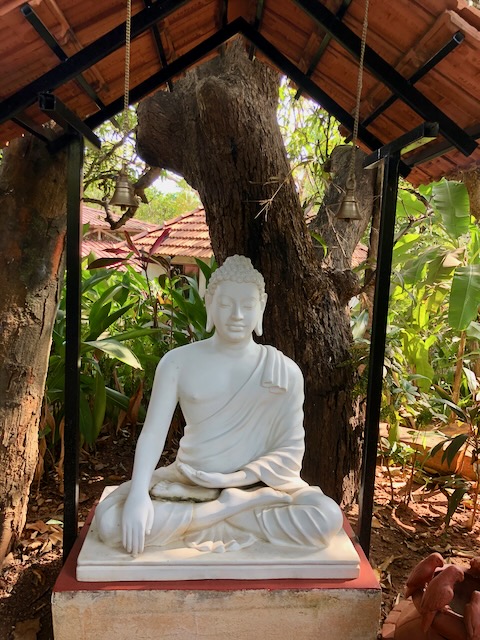
After a long journey first to Frankfurt, then to Mumbai, and finally to Goa, I arrived at Preksha Yoga Ashram around 7am local time. I had been traveling for more than 24 hours and I was exhausted. I’m never very successful at sleeping on airplanes, so long flights are always difficult for me. After I was shown to my cabin, I made a quick call to check in with Beth, and then crashed for four hours solid. I awoke around noon for lunch, and Siddhesh, the operations manager, showed me around the ashram grounds. It was absolutely gorgeous. It was lush and green, full of tropical vegetation, beautiful flowers, and wildlife. The cabins were simple, but quite nice for India’s standards. My cabin was spacious and had enough room for a large bed (two single beds pushed together), a wardrobe, and a table where I could work. I had a large private bathroom with a western style toilet and a shower with hot water. The climate was warm and humid (in the 80’s most days and 60’s at night). Classes were held in a large outdoor yoga shala, and an open-air cafeteria where community meals were served. The food was incredible. The chef, Ashish, greeted us and served our meals while happily chatting with us. We were served vegetarian south Indian dishes that were healthy, fresh, and tasty. Lots of beans and legumes with flavorful curry sauces, lentils, kitchari, soya, cooked and raw vegetables, soups, rice, and chapati, an unleavened wheat flour flatbread that is commonly eaten throughout India. We could eat as much as we wanted, and I often overate because the food was so delicious. I could eat that kind of food every day and never get sick of it.
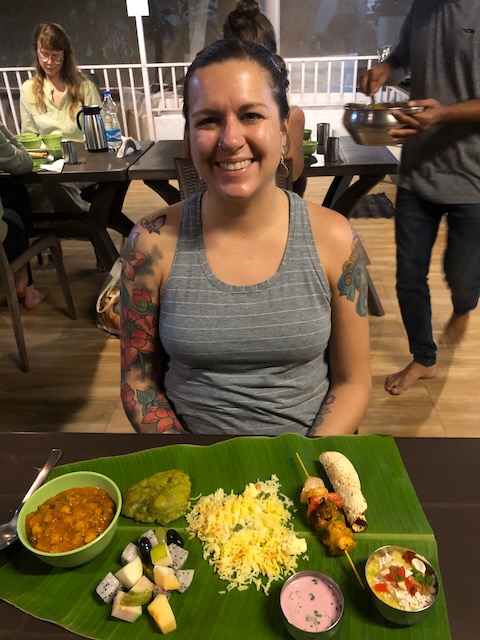
The ashram schedule was built to resemble a retreat-like experience. The morning yoga class began at 7am and was a Hatha style class which included deep stretches and long holds in poses. The sequences were fairly basic and beginner friendly because people of all levels attended the ashram. The sequences repeated each week and would start out gentler at the beginning of the week and would gradually get more challenging. We practiced different styles of pranayama for the last 15 minutes of the morning class. After class, we had breakfast, and then a long break until lunch. After lunch there was a yoga philosophy class with Bhavna, an incredible teacher who I bonded with during my time at the ashram. I rarely attended the philosophy classes because of work, but they repeated the same content each week, so I didn’t miss much. There was an afternoon yoga class before dinner, which was longer and generally a bit stronger than the morning class and didn’t include pranayama. After dinner, we finished the day with meditation led by Bhavna. We explored several different types of meditation including various breathing exercises, walking meditation, and yoga nidra. I sometimes had to miss the evening meditation to do work calls since evenings in India were mornings in Denver, but I did my best to attend as many yoga and meditation classes as I could fit in, along with evening walks to the beach and dips in the Arabian Sea before dinner. We had Sundays free, and I generally spent that time on the beach. The only drawback of the beach were the locals who would walk along the beach selling clothing, jewelry, mala bracelets and necklaces, and other trinkets. They were often pushy and aggressive, which got old after spending months there. I made the mistake of buying a few things during my first week in Mandrem and couldn’t shake them loose for the rest of my trip.
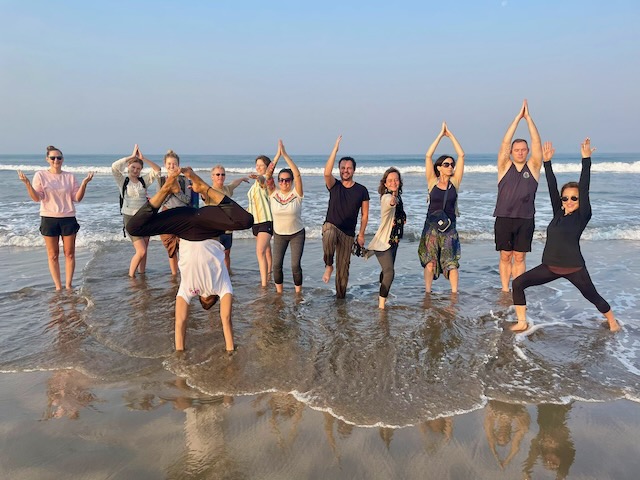
Thursdays were a special day. We started the day with a sunrise yoga class on the beach. Getting up at 5:30am was never easy, but always worth it. Mandrem beach is large and spacious. The restaurants and hotels along the beach are far from the sea during that time of year because the water moves farther inward during the monsoon season, so the beach spanned a long distance. The sand was more of a red clay that is firm when wet. Thursday evenings we had a “special dinner,” and we were served richer, more traditional Goan style foods on a banana leaf. Some of the dishes included paneer masala, chickpea masala, grilled skewered vegetables, papadum, pakora, and a lentil or rice-based custard dessert. Special dinners were followed by community kirtan instead of meditation. We would sing and chant together, and often different travelers with singing or musical talents would lead the group.
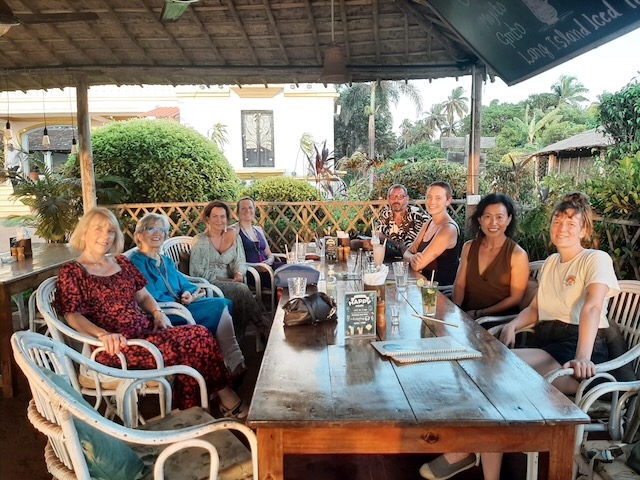
Travelers from all over the world came and went during my three months. Many were from Europe – Germany, England, France, Italy, Sweden. Others were from different parts of the world – Australia, Israel, Estonia, Central and South America, Mexico, Canada, and other parts of India. Most would stay for a week or two, a few would stay for a month, and a handful stayed for a couple months. I stayed the longest. I bonded quickly with a couple of the other long termers. We spent day after day together, practicing yoga and meditation, and eating every meal together. It was like suddenly having a bunch of roommates. Most days it was fun to have so many people around me, but some days were difficult. I never had the option to have an off day and be alone, and it was sometimes difficult to always be “on” and feel pressured to socialize. I struggled with my work responsibilities, while most of the other travelers were on holiday or long trips that didn’t include work. I felt envious of them and resentful that I had to work so much and miss out on getting the fullest benefit of my experience there.
During the first couple weeks of my trip, I experienced a lot of challenges with internet and power outages. I almost ended my trip early because the connectivity issues were making it nearly impossible to keep up with my workload and effectively run my business. But Siddhesh went above and beyond to make sure that my stay was comfortable, and ended up installing a private WiFi line outside of my cabin, as well as a battery powered backup electrical socket inside my cabin. It wasn’t a perfect solution and there were still outages, but it mitigated the majority of the issues, and I was able to work again.
But even after the internet and power outage issues were resolved, I continued to struggle with my work. I was overwhelmed with my workload and could barely fit it all in between yoga and meditation classes. The stress felt defeating especially since I had come there to get my spiritual practices back on track. I had a part-time contractor who had been working with me for about eight months, but she was creating more stress for me than she was alleviating. I ended up letting her go at the end of February and hired an old coworker, who started working with me in March. I spent the entire month of March recording training videos to get her up to speed. By April she was able to take a good amount of my work off my plate, which relieved a lot of my stress. But it was during that time that I began to realize that my work was making me very unhappy.
It wasn’t just the workload; it was the nature of the work itself. It is thankless, deadline-driven, stressful at times and mundane at others. Working with so many clients in different industries with different personalities was an added challenge. Some were responsive and easy to work with, but the majority merely saw us as a cost center and didn’t value or prioritize the work we did. We couldn’t do our job successfully without their consistent communication, and we were regularly running into roadblocks because of unresponsive clients. My master’s degree and years of experience had elevated my skills beyond bookkeeping, and I was ready to advance to higher level work. But I was working primarily with small startups and sole proprietors who either didn’t have the need or the funds for the work I wanted to do. This was a tough realization to come to. I had spent tens of thousands of dollars on my education, and countless hours building my business. By this point in my career, I had more than a decade of experience. I wasn’t sure how I was going to pivot into something more fulfilling and still be able to make the same kind of money, without having to start over completely.
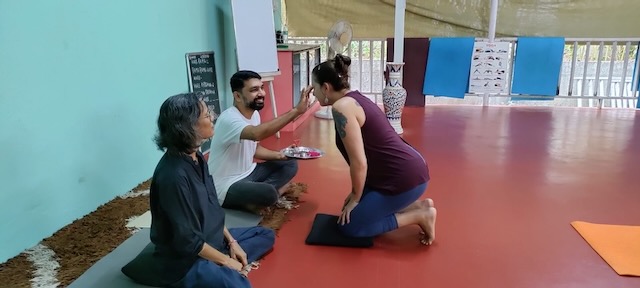
In March I participated in a 15-hour stress workshop with Bhavna. It was a weekend intensive that was intended to train us to understand and manage stress using the tools of yoga and meditation. The workshop started out with three participants including me, but the other two dropped out after the first day, so I ended up getting a one-on-one experience. This allowed me the space to open up more and utilize Bhavna’s training and expertise in counseling, trauma, and meditation. We did several hours of private yoga nidra sessions, journaling exercises, and had discussions where she offered helpful suggestions and motivation to help me through my personal and work struggles. She created a custom routine for me to implement when I returned home which included daily meditation and pranayama practices, dietary changes, and fulfilling hobbies to break up the monotony of work. That workshop made a huge difference for me and started to give me hope that I could find balance in my life again.
The distance, time difference, and my work stress put a significant strain on my relationship with Beth. Six weeks in she tried to break up with me, despite her promise that she wouldn’t. I was able to talk her into waiting until I returned home so we could talk things through in person, but that moment changed our relationship. I didn’t feel that I could open up to her anymore about my struggles. I did my best to put on a happy face for her for the rest of my trip, but I was silently struggling and didn’t feel I had a supportive partner to turn to.
Mandrem
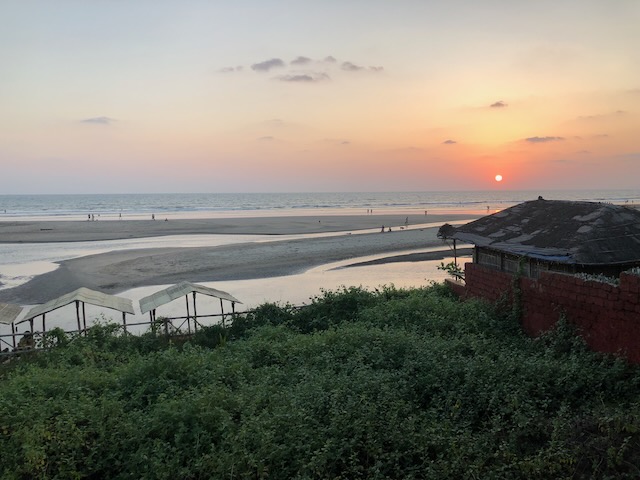
Mandrem is a small coastal village located in North Goa. Mandrem and the surrounding villages attract many tourists during the high season, between October and March. The rest of the year is considered the off-season because of the harsh weather conditions. April gets very hot and humid as the monsoon season approaches. The monsoons begin in mid to late May and last until September, which bring heavy rains and intense heat and humidity, with the majority of the rainfall in July and August. I wasn’t aware of this when I booked my stay through the end of April, but thankfully I like the heat. However, many of the shops and restaurants began to close down for the season around the middle of April.
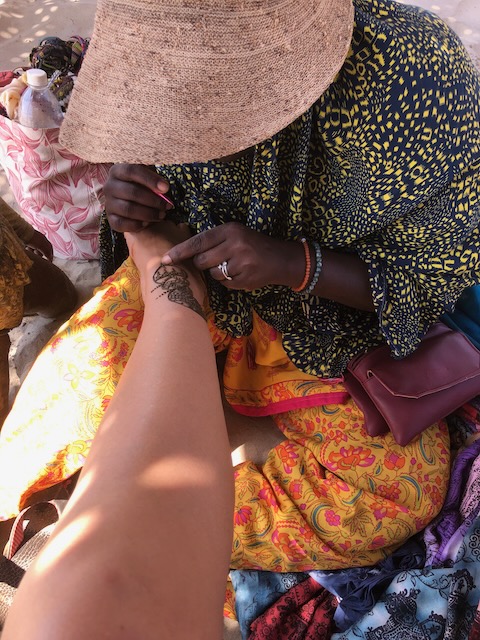
Indians who live in states throughout the country come to Mandrem and other parts of Goa during the high season to sell jewelry, clothing, handmade goods, and/or run shops or restaurants. Goa is one of the states that attracts the most tourism, which provides opportunities for Indians to make enough of a living to sustain them through the off-season. I had several conversations with the ladies who walked the beaches daily selling jewelry and clothing they had made. They shared with me about the challenges of depending on tourism, especially during the pandemic while tourism was shut down in India for more than two years. Unfortunately, they weren’t just befriending me to chat, there was always an expectation for me to buy something. While I had compassion for them, I couldn’t keep buying from them for three months, and they would sometimes leave the conversation angry. It felt frustrating to be treated like a checkbook, but I also tried to understand things from their perspective. I could never relate to a life that difficult, never knowing whether you were going to make enough money to feed your family.
Along Mandrem beach, there are restaurants and resorts with beautiful views of the ocean. Although I ate most of my meals at the Ashram, I sometimes ate meals and/or worked from restaurants and had some very delicious traditional Indian foods. There are also some shops, but the best place to shop in the area is in the next town over called Arambol. Arambol is within walking distance from Mandrem, and I visited the village several times during my stay, both for shopping and beach days, as well as for a tantric love workshop that a few of my ashram friends and I participated in.
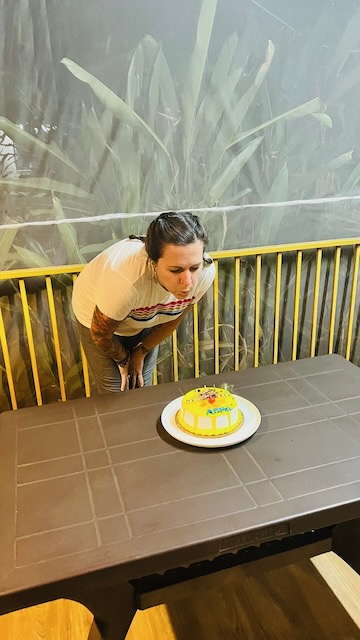
I had my 40th birthday while I was in Mandrem. Two other ladies and I hired a driver and did a tour of south Goa that day. We visited a couple cathedrals, a Hindu temple, and a couple beaches. When I returned to the ashram, there was a “happy birthday” sign and a dozen roses in my cabin. They also bought me a birthday cake which was a rare delicacy at the ashram, and everyone sang to me before enjoying the sweet treat.
Mandrem was somewhat peaceful compared to some of the other places in India that I have visited and heard about. But it’s still India. They drive like maniacs, it’s noisy and polluted, and stray animals and poverty are rampant. But Mandrem is unique in the sense that it is primarily a seasonal destination, so it seemed a bit cleaner and more orderly. There are also liquor stores and bars in Goa, which is uncommon in other parts of India. The reason for this is because there is a large population of Russians in Goa. Around 50 years ago, a large number of Russians moved into south India and took over things for a while. They overpowered and corrupted the Indian police and forced many natives out of their homes and businesses. Over the years, the Indians have regained some of their power and somewhat equalized things, but there are still many Russians who live in south India either permanently or seasonally. Despite the chaos though, Preksha Yoga Ashram provided me with a safe and quiet place to retreat (most of the time).


